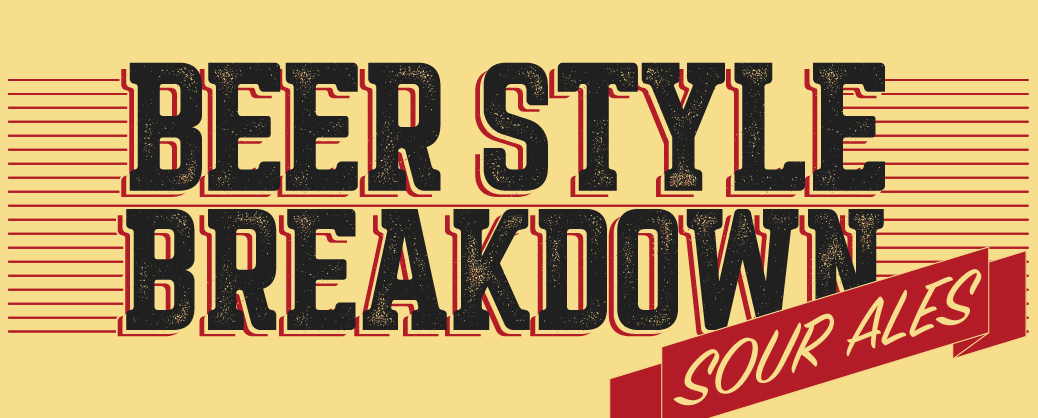Beer Style Breakdown: Sour Ales
Jun. 25, 2017

When is the last time you had a customer comment that his or her beer had the aroma of a wet horse blanket? Or hints of barnyard funk? If you have a strong sour beer program, then those compliments might be rather common for you.
Tart and sour ales have been a growing trend in the craft beer industry for a few years now. While palate-punishing IPAs continue to receive your customers’ dollars, it is well worth it to most accounts to dedicate a draft line, or at least some cooler space, to some more experimental sour ales as well.
Not sure where to start? Pucker up and allow us to demystify some of these more complex and misunderstood ales for you.
European Sour Ales
As an overarching category, European sour ales almost always have a wheat component, which is what gives these beers their soft, almost velvety mouthfeel. Traditionally, most European sour ales have low-to-no perceived bitterness, and instead rely on the sourness of the beer to provide the balance that hops normally would.
Berliner Weisse
Origin: Berlin, Germany, late Middle Ages
ABV: 4.5-6.2%
SRM: 5-14 – Very pale straw
Bitterness: 3-8 IBUs – Very low bitterness
Berliner Weisse is a top-fermented, bottle-conditioned wheat beer made with both traditional warm-fermenting yeasts and lactobacillus culture. Tart, spritzy and low in alcohol, these beers are the perfect summertime thirst quencher.
Originally Berliner Weisse-style wheat beers were brought over to American by German brewers after the Civil War. For a long while the style was a mainstay for most breweries, but after Prohibition, the style struggled to return to its former glory. Over the past three years, however, the style has rebounded as consumers continue to seek out more interesting, sessionable beverage options.
Gose
Origin: Northern Germany, late Middle Ages
ABV: 4.2-4.8%
SRM: 3-4 – Very pale straw
Bitterness: 5-12 IBUs – Very low bitterness
Goses are highly carbonated, tart and fruity wheat ales which often have hints of coriander and a slightly briny, sea salt character. Very low in alcohol and incredibly refreshing, Goses are unfiltered and when served in a cylindrical glass, they are almost mirage-like on a hot summer day.
The name Gose comes from the beer’s historic home city of Goslar on the Gose River. Similar to the Berliner Weisse, Goses are making a comeback in the U.S., with many breweries adding fruits and botanicals – like blackberries, watermelon and blood orange – to add a level of innovation to the historically rich style.
Lambic (Unblended and Fruit)
Origin: Brussels, Belgium, the exact date is not known, but spontaneously fermented ales have been produced in the region for centuries.
ABV: 5.0-8.1%
SRM: 6-13 – Bright gold (But will vary depending on the fruit that is added)
Bitterness: 9-23 IBUs – Low bitterness
Lambics are fairly sour, moderately funky wild Belgian wheat. Traditional unblended Lambics are spontaneously fermented in large, open air tanks, which produce wild and highly acidic flavors and are served under-carbonated.
Fruit Lambics are made from the same base beer, but with the added addition of fruit. Originally the fruit was added to the beer simply to expand the variety of offerings the bar had. Now, brewers are more likely to add fruit to balance out the acidity and make them more palatable to a wider audience.
American Wild Ales
The American wild ale category encompasses a wide range of beers that do not fit traditional European sour or wild styles. It’s a term craft brewers are using to describe their beers that are either spontaneously fermented or simply influenced by microbes other than traditionally cultivated brewer’s yeast.
A few examples of beers that fall into this category are brett beers, mixed-fermentation sours and wild ales.
Ask a Cicerone: Advice from David Kahle, Master Cicerone and Breakthru Beverage Illinois Craft Beer Specialist
Sour Appeals to an Adventurous Palate
“Traditionally Americans have been focused on sweet and salty flavors, but there is now this movement towards exploring more intense flavors like bitterness and sour. That is one reason why IPAs have become forward the palates of Americans. Sour is kind of in that same adventurous realm and seems to be next in-line for consumers’ interest.”
Start by Bringing in Bottles
“It is a low-risk proposition to pick up some sour beer in bottles. They are not perishable like IPAs and other standard American craft beers. Beers like Gueze, Lamic and Flander’s Red can hold up for years in the bottle.”
Tart is also a Good Place to Start
“If you have customers asking for sours and you just want to get your feet wet, I would look at bringing in a few tart beers instead of the more aggressively sour ales. Gose, Berliner Weisse or a tart American Wheat are all great beers to start off with. Those styles of beer don’t have a ton of acidity but have enough tartness to be refreshing.”
Keep Your Lines Clean
“Once you have a sour or tart beer on a draft line, going forward, you should probably keep that line dedicated for sour beers. In terms of draft line maintenance and cleaning, if you’re only pouring a tart beer, then regular line cleaning should be fine. If you’re switching the beer on that tap from a true sour with live or wild microbes, to an IPA or something like that, then you would probably want to switch out your jumper line and do a deeper system clean.”
Small Pours, Big Flavors
“Most of these tart and sour ales are accessibly priced. I don’t think an account should be afraid to charge one dollar an ounce for a real sour on draft. These don’t need to be large pours either. An eight or 10-ounce pour is the perfect size for most of these beers.”
